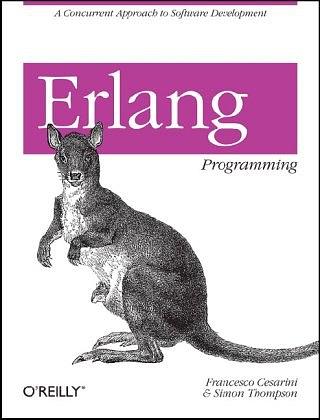
书名:Erlang Programming
作者:FrancescoCesarini/SimonThompson
译者:
ISBN:9780596518189
出版社:O'ReillyMedia
出版时间:2009-6-19
格式:epub/mobi/azw3/pdf
页数:496
豆瓣评分: 8.3
书籍简介:
This book is an in-depth introduction to Erlang, a programming language ideal for any situation where concurrency, fault tolerance, and fast response is essential. Erlang is gaining widespread adoption with the advent of multi-core processors and their new scalable approach to concurrency. With this guide you'll learn how to write complex concurrent programs in Erlang, regardless of your programming background or experience. Written by leaders of the international Erlang community — and based on their training material — Erlang Programming focuses on the language's syntax and semantics, and explains pattern matching, proper lists, recursion, debugging, networking, and concurrency. This book helps you: Understand the strengths of Erlang and why its designers included specific features Learn the concepts behind concurrency and Erlang's way of handling it Write efficient Erlang programs while keeping code neat and readable Discover how Erlang fills the requirements for distributed systems Add simple graphical user interfaces with little effort Learn Erlang's tracing mechanisms for debugging concurrent and distributed systems Use the built-in Mnesia database and other table storage features Erlang Programming provides exercises at the end of each chapter and simple examples throughout the book.
作者简介:
Francesco Cesarini 14年来一直向学生、开发人员、测试人员、项目和技术经理教授Erlang/OTP技术。他协助在爱尔兰、美国和英国建立起了Erlang开发中心。
Simon Thompson是一位肯特大学计算机实验室的逻辑和计算学教授,在过去25年里,他在那里教授本科生和研究生的计算学课程。
书友短评:
@ hoterran 普通。 @ ning 比较系统,比Armstrong的书 @ [已注销] 入了kindle,第一本打算看它从图书馆借了本实体书,每读一遍都有收获 @ 不正直的绅士 涵盖了Erlang的各方面,比Joa的那本Erlang程序设计要详细。 @ RaymondChou 结构还算比较清晰。 @ tingliang 作为Programming Erlang 辅助书很不错,偏细节 @ 雨果僧 着重看了socket那块的编程,是一本好书~适合入门。网上有一些翻译http://gashero.yeax.com/?p=55#id11 @ 八牛 其实erlang也不是很难嘛,估计是还没入门 @ [已注销] 入了kindle,第一本打算看它从图书馆借了本实体书,每读一遍都有收获 @ KLu 入门可看,可粗略浏览完后查阅细节
Chapter 1 Introduction
Why Should I Use Erlang?
The History of Erlang
Erlang’s Characteristics
Erlang and Multicore
Case Studies
How Should I Use Erlang?
Chapter 2 Basic Erlang
Integers
The Erlang Shell
Floats
Atoms
Booleans
Tuples
Lists
Term Comparison
Variables
Complex Data Structures
Pattern Matching
Functions
Modules
Exercises
Chapter 3 Sequential Erlang
Conditional Evaluations
Guards
Built-in Functions
Recursion
Runtime Errors
Handling Errors
Library Modules
The Debugger
Exercises
Chapter 4 Concurrent Programming
Creating Processes
Message Passing
Receiving Messages
Registered Processes
Timeouts
Benchmarking
Process Skeletons
Tail Recursion and Memory Leaks
A Case Study on Concurrency-Oriented Programming
Race Conditions, Deadlocks, and Process Starvation
The Process Manager
Exercises
Chapter 5 Process Design Patterns
Client/Server Models
A Process Pattern Example
Finite State Machines
Event Managers and Handlers
Exercises
Chapter 6 Process Error Handling
Process Links and Exit Signals
Robust Systems
Exercises
Chapter 7 Records and Macros
Records
Macros
Exercises
Chapter 8 Software Upgrade
Upgrading Modules
Behind the Scenes
Upgrading Processes
The .erlang File
Exercise
Chapter 9 More Data Types and High-Level Constructs
Functional Programming for Real
Funs and Higher-Order Functions
List Comprehensions
Binaries and Serialization
References
Exercises
Chapter 10 ETS and Dets Tables
ETS Tables
Dets Tables
A Mobile Subscriber Database Example
Exercises
Chapter 11 Distributed Programming in Erlang
Distributed Systems in Erlang
Distributed Computing in Erlang: The Basics
The epmd Process
Exercises
Chapter 12 OTP Behaviors
Introduction to OTP Behaviors
Generic Servers
Supervisors
Applications
Release Handling
Other Behaviors and Further Reading
Exercises
Chapter 13 Introducing Mnesia
When to Use Mnesia
Configuring Mnesia
Transactions
Partitioned Networks
Further Reading
Exercises
Chapter 14 GUI Programming with wxErlang
wxWidgets
wxErlang: An Erlang Binding for wxWidgets
A First Example: MicroBlog
The MiniBlog Example
Obtaining and Running wxErlang
Exercises
Chapter 15 Socket Programming
User Datagram Protocol
Transmission Control Protocol
The inet Module
Further Reading
Exercises
Chapter 16 Interfacing Erlang with Other Programming Languages
An Overview of Interworking
Interworking with Java
C Nodes
Erlang from the Unix Shell: erl_call
Port Programs
Library Support for Communication
Linked-in Drivers and the FFI
Exercises
Chapter 17 Trace BIFs, the dbg Tracer, and Match Specifications
Introduction
The Trace BIFs
Tracing Calls with the trace_pattern BIF
The dbg Tracer
Match Specifications: The fun Syntax
Match Specifications: The Nuts and Bolts
Further Reading
Exercises
Chapter 18 Types and Documentation
Types in Erlang
TypEr: Success Types and Type Inference
Documentation with EDoc
Exercises
Chapter 19 EUnit and Test-Driven Development
Test-Driven Development
EUnit
The EUnit Infrastructure
Testing State-Based Systems
Testing Concurrent Programs in Erlang
Exercises
Chapter 20 Style and Efficiency
Applications and Modules
Processes and Concurrency
Stylistic Conventions
Coding Strategies
Efficiency
And Finally…
Appendix Using Erlang
Getting Started with Erlang
Tools for Erlang
Where to Learn More
Colophon
· · · · · ·
添加微信公众号:好书天下获取
 好书天下
好书天下
评论前必须登录!
注册